- Author: Kathy Keatley Garvey
Migrating monarchs are fluttering daily into our yard in Vacaville, Calif., one by one, two by two, three by three, and four by four, for a little flight fuel. They're sipping nectar from the Mexican sunflower, Tithonia rotundifolia, and tropical milkweed, Asclepias curassavica.
They're on their way to overwintering sites, such as the Natural Bridges State Park's Monarch Grove Butterfly Natural Preserve, Santa Cruz.
The park's monarch sanctuary "provides a temporary home for thousands of monarchs," according to the website. "In 2016, 8,000 monarch butterflies overwintered at Natural Bridges. From late fall into winter, the monarchs form a 'city in the trees.' The area's mild seaside climate and eucalyptus grove provide a safe place for monarchs to roost until spring."
The numbers typically peak between late October to mid-November. It's an awe-inspiring place, especially if you rear monarchs. And admission is free. The preserve is open to the public from 8 a.m. to sunset daily, or visitors can participate in a free one-hour tour on Saturdays and Sundays at 11 a.m. to 2 p.m.
Meanwhile, scores of monarchs are on their way. Some won't make it. Predators, especially birds, will nail many of them. The weather will deter many others.
We know of at least one that probably won't make it. On Friday, Oct. 27, while we were gathering mllkweed seeds from the Asclepias curassavica, we noticed two lady beetles feasting on aphids.
Wait, what's that beneath that leaf?
Could it be? It was. A monarch caterpillar! Talk about late!
The 'cat is now tucked inside our indoor butterfly habitat, munching on milkweed leaves. With any luck, it will become a mid-life chrysalis and then an adult monarch.
It will take a lot of luck, however, for it to join its buddies in Santa Cruz. Its late start will be exacerbated by the cold, the wind, the rain, the predators....
On a wing and a prayer...
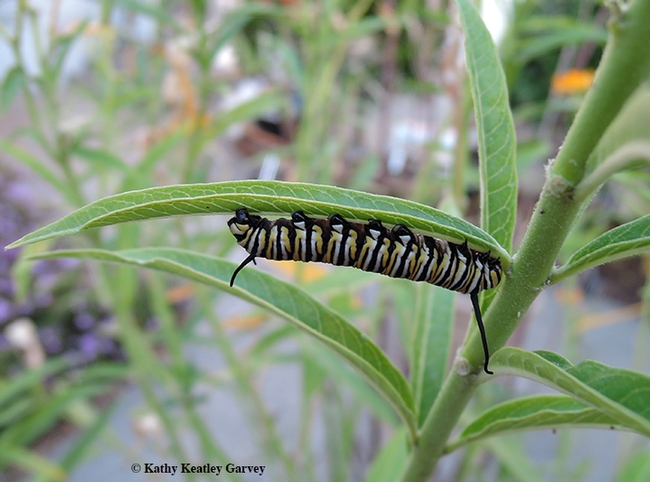
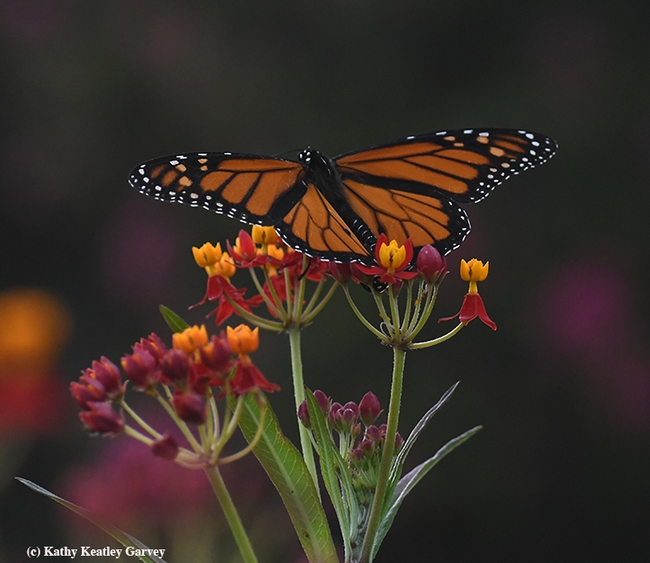
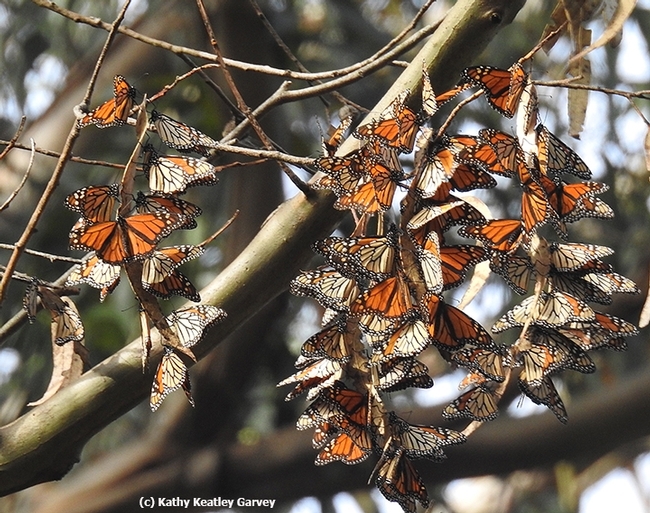
- Author: Kathy Keatley Garvey

A Sept. 7 article in Reuters, headlined "Monarchs in Western United States Risk Extinction, Scientists Say," indicated that "Monarch butterflies west of the Rocky Mountains are teetering on the edge of extinction, with the number wintering in California down more than 90 percent from the 1980s, researchers said in a study published on Thursday."
Reuters' reporter Laura Zuckerman wrote that "The migratory monarchs of the western United States have a 63 percent chance of extinction in 20 years and an 84 percent chance in 50 years if current trends continue, according to the study."
The scientists, led by Washington State University conservation biologist Cheryl Schultz, published their work in the journal Biological Conservation. It was funded by the U.S. Fish and Wildlife Service, which is weighing the prospect of offering federal protection for monarch butterflies through the Endangered Species Act. The Xerces Society for Invertebrate Conservation is among those spearheading the effort.
Noted lepidopterist Arthur Shapiro, UC Davis distinguished professor of evolution and ecology who has studied butterflies, including the monarchs, for more than four decades, doubts that the western monarchs are teetering on the edge of extinction.
Shapiro, who maintains a website, Art's Butterfly World. says that yes, the western monarchs have been declining faster than the eastern monarchs, as per the Biological Conservation paper. However, during the drought, California populations appeared to rebound significantly, and it is not known whether the trend will persist, he says.
Their comprehensive and well-researched work, titled "Understanding a Migratory Species in a Changing World: Climatic Effects and Demographic Declines in the Western Monarch Revealed by Four Decades of Intensive Monitoring," was funded in part by the National Science Foundation. Their Oecologia abstract: "Migratory animals pose unique challenges for conservation biologists, and we have much to learn about how migratory species respond to drivers of global change. Research has cast doubt on the stability of the eastern monarch butterfly (Danaus plexippus) population in North America, but the western monarchs have not been as intensively examined. Using a Bayesia hierarchial model, sightings of western monarchs over approximately 40 years were investigated using summer flight records from ten sites along an elevational transect in Northern California."
"Multiple weather variable were examined, including local and regional temperature and precipitation. Population trends from the ten focal sites and a subset of western overwintering sites were compared to summer and overwintering data from the eastern migration. Records showed western overwintering grounds and western breeding grounds had negative trends over time, with declines concentrated early in the breeding season, which were potentially more severe than in the eastern population."
"Temporal variation in the western monarch also appears to be largely independent of (uncorrelated with) the dynamics in the east. For our focal sits, warmer temperatures had positive effect during spring. These climatic associations add to our understanding of biotic-abiotic interactions in a migratory butterfly, but shifting climatic conditions do not explain the overall, long-term, negative population trajectory observed in our data."
In acknowledgments, Shapiro and his colleagues thanked the Xerces Society for Invertebrate Conservation and the North American Butterfly Association for the monarch counts and making the data publicly available.
Meanwhile, since late August, the western monarchs (Arizona, California, Nevada, Oregon, Washington, Idaho and Utah) have been winging their way to their overwintering spots to forested groves along coastal California.
And then, around February, they will head inland to start the process again.
It's an amazing phenomenon.
As I write this, four monarchs are gathering some flight fuel, nectaring from two M's: milkweed and Mexican sunflower in our little pollinator garden in Vacaville, Calif., part of their migratory path to the coast. They flutter from flower to flower, seemingly unaware of the California scrub jay circling them and a photographer zeroing in on them. Or the rain about to fall.
Resources:
Monarch Conservation, Xerces Society for Invertebrate Conservation
Xerces Society's Western Monarch Thanksgiving Activity Count
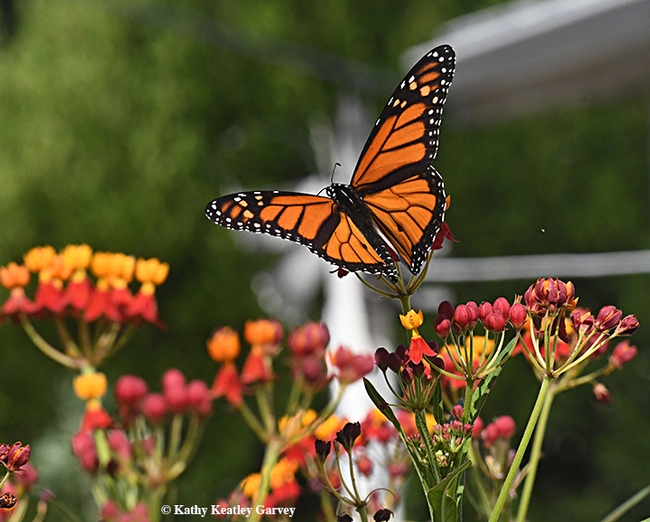
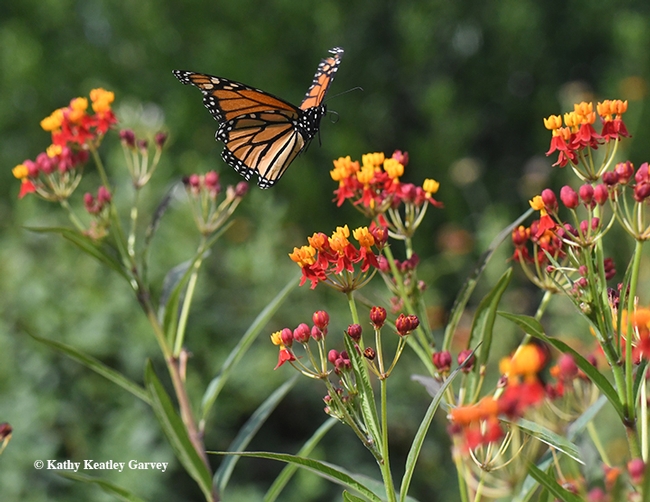
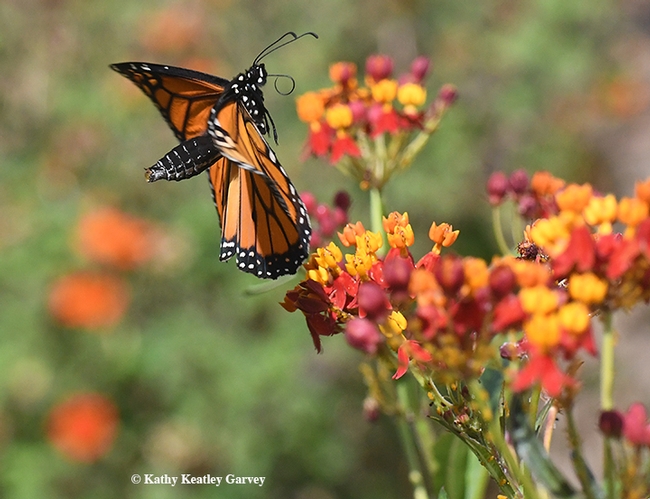
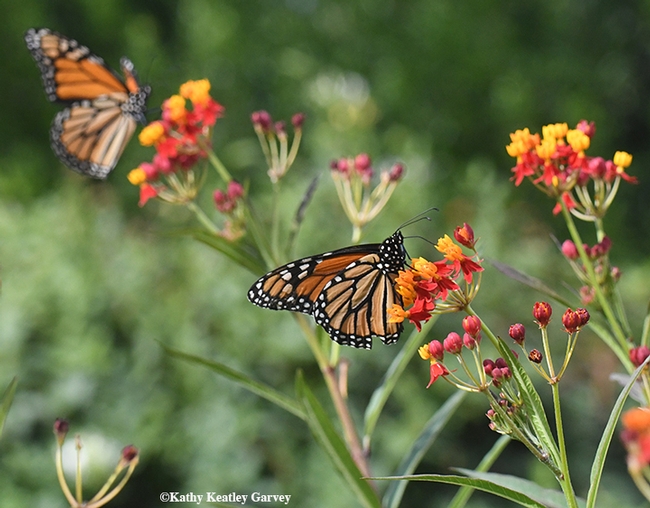
- Author: Kathy Keatley Garvey

For years we've marveled at the migrating whales passing Point Reyes as we stood glued to our binoculars.
And we've expressed awe that a bird--a plover--makes nonstop flights over the central Pacific Ocean from Alaska to Australia and New Zealand.
Amazing. Nothing short of incredible, especially when you consider that many homo sapiens can't find their way out of a parking lot.
They're all on the move. But how many of us have seen the lesser known migrants, such as winged aphids, ballooning spiders, mites, locusts, pelicans, grasshoppers, and armyworm moths, on the move?
Enter Hugh Dingle, an emeritus professor of entomology at the University of California, Davis, and a worldwide authority on animal migration.
Dingle, who was featured in National Geographic's cover story on "Great Migrations in November 2010 and interviewed by LiveScience for its November 2010 piece on “Why Do Animals Migrate?", has just published the second edition of his book, Migration: The Biology of Life on the Move (Oxford University Press), a sequel to the first edition published in 1996.
The full understanding of migration, or “life on the move,” involves genetics, physiology, and morphology, as well as behavior and ecology, Dingle says.
"The program or syndrome includes specific modifications of metabolic physiology like enhanced fat storage to fuel migration and of sensory systems to detect inputs from the sun, stars, and magnetic field lines to determine compass direction. Intimately involved in the latter are daily and yearly biological clocks. The pathway followed is an outcome of the syndrome of migratory behavior and is part of the ecology that provides the natural selection acting to determine the evolution of migration.”
Not all migration is a round trip; sometimes it's one-way, Dingle says. “Important defining behavioral characteristics are specific departure and arrival tactics and the refusal to stop even in favorable habitats until the migration program is complete,” Dingle says. “In the words of National Geographic reporter David Quammen migrants ‘are flat-out just gonna get there.'"
Why is it important to understand the biological basis of migration and its evolution? “Because migration is so widespread and because migrants have such impact on both natural and man-altered ecosystems,” says Dingle, who achieved emeritus status in 2003 after serving on the faculty of the UC Davis Department of Entomology (now the UC Davis Department of Entomology and Nematology) from 1982 to 2002.
In his book, Dingle covers the interaction between behavior and outcome. Another important focus: he covers the relation between migration and life histories, including the evolutionary genetics of the relationship. Long-distance round-trips, for example, require long lifespans, hence most insects, although not all, migrate only one-way.
“Natural selection acts differently on long versus short lives," Dingle says. "With long lives there are usually many opportunities to produce offspring; with short lives there may be only one. Thus reproductive opportunities may determine when and where to migrate. Migrating aphids postpone reproduction until they colonize new host plants; birds reproduce following migration in the spring, but not in the fall. Some birds and insects use migration to exploit ‘rich patches' and breed in different places in different years or even in the same year."
Dingle, former secretary of the International Society for Behavioral Ecology and past president of the Animal Behavior Society, says he wrote the book for "students of migration and for those biologists who are generally interested in the functioning and adaptations of whole organisms."
Dingle is a fellow of the American Association for the Advancement of Science and the Animal Behavior Society. His research has taken him throughout the world, including the UK, Kenya, Thailand, Panama, Germany and Australia.
In some respects, he, too, migrated.

- Author: Kathy Keatley Garvey
The painted ladies are on move.
Butterflies.
Scores of painted ladies (Vanessa cardui) are now migrating north from their overwintering sites near the U.S. Mexico border.
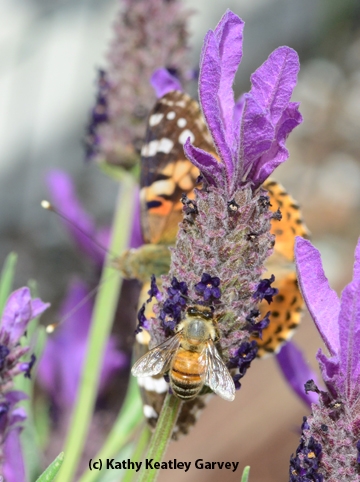
"Fascinatingly, they arrived in Prescott, Ariz., the same day (as the ones spotted in Benicia)," said butterfly expert Art Shapiro, distinguished professor of evolution and ecology at the University of California, Davis. "I think they're all from south of the border." The annual migration north varies, but can take place as early as late January and as late as mid-April.
The painted ladies spend the winter in the desert, where in the late winter, they breed on desert annual plants, Shapiro says. The adults emerge in February or March and immediately migrate into the Central Valley and foothills, where they breed. Around May, here in the Central Valley, you'll see the caterpillar offspring munching on borage, thistles, fiddleneck and mallows. Then the adults head toward the Pacific Northwest.
"The painted lady moves northward in a generational wave as the season progresses," Shapiro says on his website. "Frequently it disappears altogether from the lowlands in summer. Beginning in August the movement reverses and butterflies head south toward the desert wintering grounds."
"There is no evidence that this species overwinters successfully anywhere in our area, except for very rare individuals maturing in midwinter from really late autumnal larvae."
The painted lady migration may not be as popular as the monarch (Danaus plexippus) migration, but it's fascinating just the same.
Shapiro, who has monitored the butterfly population of California's Central Valley for 42 years, will be speaking at noon on Monday, March 24 on "Ecological Communities and the March of Time" in the Commonwealth Club, 595 Market St., San Francisco. For program detail and registration, please see the club website. His talk is open to the public. For a discount, access the website and use the coupon code, "friendsforshapiro," said spokesperson Chisako Ress (chisakoress@gmail.com).


- Author: Kathy Keatley Garvey
The painted ladies are back.
No, not the Victorian and Edwardian homes painted in three colors. No, not women wearing excessive amounts of makeup and pounding the sidewalk with their stiletto heels.
These are BUTTERFLIES.
"Another Painted Lady (Vanessa cardui) migration is occurring in north-central
Why hints of overwintering and breeding? Because the insects "were in good condition and did not appear to have migrated long distances," Shapiro says. "They also did not show the usual color-and-pattern signs of having been generated in the desert, but they were not produced locally in the Davis-Sacramento region and were seemingly confined to the west side of the Valley."
Shapiro reports that the
We saw them last weekend passing through parts of Solano and Yolo counties. They were moving fast and flying low.
"These butterflies are powered by yellow fat carried over from the caterpillar stage and fly like 'bats out of hell' from the Southeast to the Northwest a few feet off the ground, not stopping for food or sex until their fat reserves become depleted," Shaparo. He spotted a few feeding and one female was laying eggs.
Shapiro is updating the migration on the home page of his Web site. It's a must-read. You can learn more about Painted Ladies inside his Web site. See also pages 48-51 and 195-200 of his Field Guide to Butterflies of the San Francisco Bay and Sacramento Valley Regions (
Got a migration report or a video to offer him for his Web site? You can email him at amshapiro@ucdavis.edu.
Meanwhile, those Painted Ladies are absolutely gorgeous. We've heard far too much about ballistic bailouts, burgeoning bonuses and mortage meltdowns--and not enough about the Painted Ladies.
Bring 'em on!



